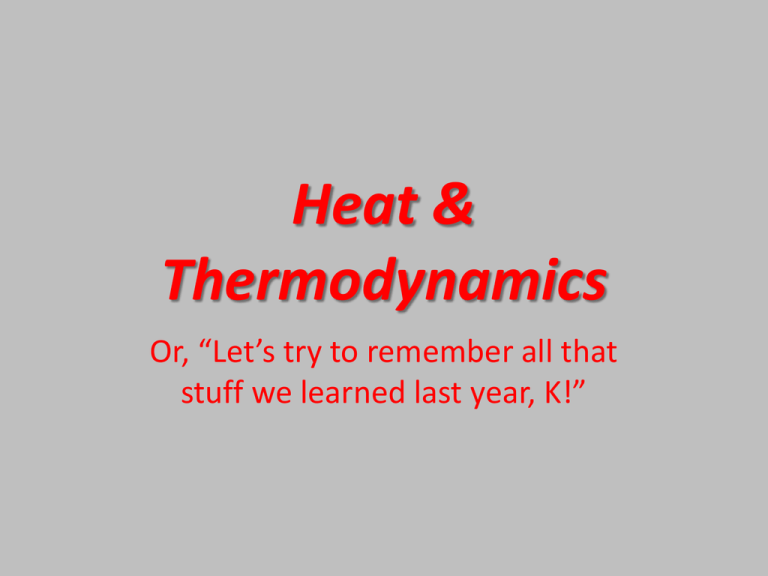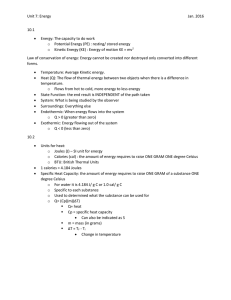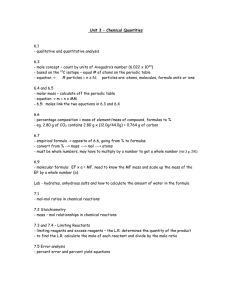Heat & Thermodynamics Or, “Let’s try to remember all that
advertisement

Heat & Thermodynamics Or, “Let’s try to remember all that stuff we learned last year, K!” Seriously… • Whatsup? –Ch 13, 14, & 15 simultaneously • Ch13: Temp, Kinetic Theory & Gas Laws • Ch14: Heat & Heat Transfer • Ch15: Thermodynamics –Regular HW & WSs each chapter. • DUE DATES? Definitions & Such • Heat –Energy that ‘flows’ from hot to ‘cold’ object. – NOT AVERAGE kinetic energy of the molecules in an object. • Temperature – Method of measuring Heat. • 4 Scales – F, C, R, K 491 180 671 459 32 491 Figure 13.6 • Relationships between the Fahrenheit, Celsius, and Kelvin temperature scales, rounded to the nearest degree. The relative sizes of the scales are also shown. Definitions & Such • Units of Heat Energy – Joule : Amount of energy that = 4.186-1 cal. • SI Unit for Work & Energy kg m kg m J Nm 2 m 2 s s 2 Joules Mechanical Equivalency Experiment T PE mgh Smithsonian Nat’l History Museum Mini-LAB 100 Revs. MEASURE T. -Record on WhiteBd -Discuss Mini-LAB Errors? -Human -Non-Insulated -Sound -Light -Time Definitions & Such • Units of Heat Energy –Calorie : Amount of energy needed to raise one gram of water 1oC. • Related to SI Unit for Work & Energy • NOT the same as a nutritional Calorie. –Cal = 1000 cal = 1 KiloCalorie …AND PLASMA! (The 4th State of Matter) • Plasma is ionized gas. • Makes up 99% of the Universe! – Ion? • Charged particles that make up the atom. • Atoms have gained so much heat that they have shaken themselves apart. • A collection of electrons and nucleusesii. Heat Flow : MV Figure 13.8 • Each increment on this logarithmic scale indicates an increase by a factor of ten, and thus illustrates the tremendous range of temperatures in nature. Note that zero on a logarithmic scale would occur off the bottom of the page at infinity. Basic LAWS • 0th Law –Two systems individually in thermal equilibrium with a 3rd system are in equilibrium with each other. –Sorta like • If A=B & B=C, then A=C Online Thermal Thing 13-2: Thermal Expansion L Lo T Figure 13.9 • Graph of pressure versus temperature for various gases kept at a constant volume. Note that all of the graphs extrapolate to zero pressure at the same temperature.. Figure 13.10 • Thermal expansion joints like these in the Auckland Harbour Bridge in New Zealand allow bridges to change length without buckling. (credit: Ingolfson, Wikimedia Commons) Figure 13.11 • In general, objects expand in all directions as temperature increases. In these drawings, the original boundaries of the objects are shown with solid lines, and the expanded boundaries with dashed lines. (a) Area increases because both length and width increase. The area of a circular plug also increases. (b) If the plug is removed, the hole it leaves becomes larger with increasing temperature, just as if the expanding plug were still in place. (c) Volume also increases, because all three dimensions increase. Figure 13.12 • The density of water as a function of temperature. Note that the thermal expansion is actually very small. The maximum density at +4ºC is only 0.0075% greater than the density at 2ºC , and 0.012% greater than that at 0ºC . Figure 13.13 • Because the gas expands more than the gas tank with increasing temperature, you can’t drive as many miles on “empty” in the summer as you can in the winter. (credit: Hector Alejandro, Flickr) Figure 13.14 • Thermal stress contributes to the formation of potholes. (credit: Editor5807, Wikimedia Commons) Figure 13.15 13-2: Thermal Expansion L Lo T A 2Ao T V Vo T 13-4 Gas Laws • Atomic & Molecular Masses –Atomic Mass; Duh! –Molecular Mass; Duh-er! • The Mole –NOT brought to you in living color on NBC! 13-4 Gas Laws • The Mole –1 mol contains as many particles of the substance as there are atoms of C12 in 12 grams! • So, Avogadro’s # of atoms or molecules… 13-4 Gas Laws • Avogadro’s #? –6.022 x 1023 • [Pass around moles] • Definition: One Mole of a thing has a mass in grams = atomic mass. –H=1, He=4, O=16, Fe=56, Taylor=Singularity 13-4 Gas Laws • Ideal Gas Laws –Boyle’s Law (1700) • P1V1=P2V2 –Charles’ Law • V1/T1=V2/T2 –Guy-Lusacs Law • P1/T1=P2/T2 Put them all together and… P1V1 P2V2 T1 T2 Which means? PV nRT NkT P1V1 n # mol CONSTANT T1 N # atoms J R 8.31 mol K 23 J k 1.38 x10 K Figure 13.19 • How big is a mole? On a macroscopic level, one mole of table tennis balls would cover the Earth to a depth of about 40 km. Figure 13.19A, B, & C • From xkcd’s, What If? How big is a mole of moles? 13-4: Kinetic Theory 113-4: Kinetic2 Theory PV Nm v 3 1 2 KE mv 2 3PV 3 Nkt 3 KE kT 2N 2N 2 Basic Stuff • Kinetic Theory –Look on pg 452+ for pix & examples 1 2 3 KE mv rms kT 2 2 13-4: Derivation of U 1 2 U N mv 2 3 3 3 U N kt Nkt nRT 2 2 2 Figure 13.22 (a) There are many molecules moving so fast in an ordinary gas that they collide a billion times every second. (b) Individual molecules do not move very far in a small amount of time, but disturbances like sound waves are transmitted at speeds related to the molecular speeds. Heat Flow : MV



